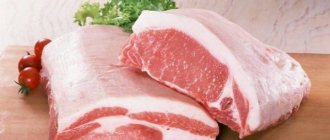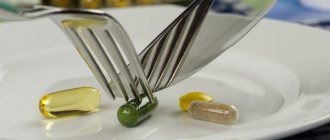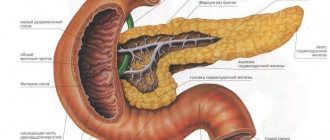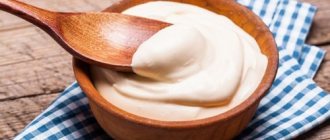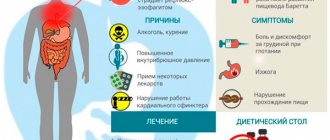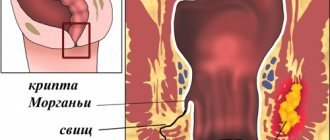How does diet number 4 help?
Crohn's disease is an inflammatory process that leads to changes in the inner wall of the intestine. Most often, the disease is localized in the small or large intestine. A treatment method that gives a chance to say goodbye to Crohn's disease forever has not yet been found, since the cause of its occurrence remains completely unexplored.
Complex therapy in combination of medications and a strict diet is aimed only at delaying the next exacerbation. Eating according to the rules prescribed by your doctor means helping your body to be in a state of stable remission.
A special diet for Crohn's disease is not provided by medicine. Of the developed therapeutic methods of nutrition, table No. 4 is considered the most suitable. The main task is to exclude products that provoke gas formation in the gastrointestinal tract. Incoming products should not irritate the mucous membrane physically, chemically or thermally. As a result of this, the following will be achieved:
- reducing the load on the entire gastrointestinal tract, including the colon;
- creating conditions for healing the mucous membrane and restoring damaged tissues;
- slowing down intestinal motility and normalizing stool.
The patient needs to understand that following a diet for Crohn's disease is part of the treatment process. The slightest disturbance, especially during an exacerbation, can lead to deterioration and lead to consequences such as intestinal perforation or obstruction. To improve the condition of the body, it is important to strictly adhere to the requirements of the Crohn's diet and not deviate from them.
Approximate daily diet
Outside of moments of exacerbation, the diet for Crohn's disease should consist of the products that were listed at the beginning of the article. Using them, you can create a similar daily menu.
- Breakfast first: semolina porridge, steamed omelette, tea.
- Breakfast two: baked apples (without crispy crusts).
- Lunch: blueberry (or pear) jelly, third chicken broth, grated carrots.
- Afternoon snack: light decoction of rose hips, white crackers.
- Dinner: rice with boiled chicken and tea.
Basic diet rules
The dietary table for Crohn's disease includes a list of generally accepted rules. Products are prescribed by the attending physician, taking into account the individual characteristics of each patient. But the main points are the same for all patients with this disease:
- Food should not irritate the intestinal mucosa. Avoid foods rich in fiber and fat.
- Dishes are prepared exclusively in a dietary manner by boiling or steaming.
- The amount of fats and carbohydrates is reduced, protein consumption is increased at the rate of 2 g per 1 kg of the patient’s body weight.
- Hard and thick foods that are difficult for inflamed intestines to digest are prohibited.
- Meals are distributed into 5–6 meals per day in small portions.
- The drinking regime must be observed: during the day you should drink 1.5–2.0 liters of liquid at room temperature.
- Herbs, spices, semi-finished products, pickles, smoked foods, and canned food are excluded.
- Salt is limited to 10 g per day.
- Food should not be hot or cold, so as not to cause an undesirable intestinal reaction to temperature.
The daily calorie intake for Crohn's disease should be calculated so that it is at least 2000 kcal. After an exacerbation of the disease due to sudden weight loss, it is recommended to include more high-calorie foods in the diet. It is also necessary to increase protein intake and supplement the diet with vitamin complexes.
Sample menu
Getting used to a new diet is quite difficult, so in order not to think every time what to cook, nutritionists recommend creating a rough menu for the whole week. Thus, for breakfast you can serve:
- cornflakes;
- baked apple or other permitted fruit;
- buttered toast;
- puffed rice;
- nutrient mixtures of liquid consistency.
https://youtube.com/watch?v=videoseries
Lunch for Crohn's disease can consist of vegetarian soup with parsley, a boiled piece of lean meat, baked river fish, a slice of white bread and compote. For dietary meals for chronic gastrointestinal diseases, vegetables are steamed, rice and pasta are boiled, and nutritional mixtures, fruits, jelly or pudding are also served.
How to eat during an exacerbation?
An exacerbation of Crohn's disease often begins with acute pain and diarrhea. At this moment, the absorption of the products entering the body does not occur; they come out with diarrhea. The doctor prescribes a 1-2 day fast for the patient with the possible introduction of nutrition through a special tube.
At this time, you are allowed to drink a decoction of chamomile or rosehip, weak tea with lemon, and low-fat kefir. It is recommended to include carrots and apples, grated on a fine grater or pureed using a blender, in the diet for Crohn's disease with diarrhea. A diet for an exacerbation of Crohn's disease without diarrhea may not include these fixative foods.
When the pain subsides, the permitted foods are introduced in small portions without variety, so that the intestines gradually begin to work. The basis of nutrition includes liquid mixtures prepared from something that will not worsen the condition. During this period, the diet for Crohn's is limited; you should definitely know what you can eat. The menu may consist of the following products:
- soups with a second broth;
- slimy porridges made from soft cereals;
- lean types of meat and fish, boiled or steamed;
- yesterday's white bread;
- jelly and jelly from berries and fruits;
- steam omelette;
- homemade cottage cheese.
The localization of inflammatory areas in Crohn's disease can be throughout the gastrointestinal tract. The degree of the disease also varies. Therefore, only the patient himself can determine which foods will irritate the intestines by observing the body’s reaction. To do this, you need to introduce 1 new product per day into your diet and note how your body reacts. It is advisable to keep records and have a daily food log. This will help you avoid repeating mistakes when the product is not suitable for the intestines, but this was forgotten.
Diet
Nutrition for Crohn's disease should be coordinated with your doctor, who determines what a person can eat. Sometimes there is a need to consult a professional nutritionist who can help you calculate your daily needs for essential nutrients.
In case of exacerbation, the diet is considered only an auxiliary measure, which is carried out while taking the necessary pharmaceuticals.
Prohibited Products
It should be understood that products whose consumption is strictly prohibited are determined individually for each patient. This may be due to the presence of concomitant pathology, the prevalence of the disease and its predominant localization.
If a person has only recently been diagnosed, it is recommended to start keeping a special diary in which he would reflect all the reactions that have arisen after eating a particular food. However, it is possible to identify products that are most often subject to prohibitions and restrictions for Crohn's disease. These include the following positions:
- All types of mushrooms, legumes, radishes, white cabbage and any other products that increase flatulence (increased gas formation, manifested by rumbling, bloating, heaviness in the abdomen);
- Raw and hard-boiled chicken eggs;
- Fatty parts of meat (lard, neck, shank, drumstick) and fish (tesha);
- Fresh vegetables, sour fruits, some greens (spinach, sorrel);
- Corn and pearl barley, millet;
- Soft pasta;
- Sweets, fresh baked goods (especially yeast), confectionery (cakes, sweets, cream, chocolate), as well as ice cream;
- Various sauces and additives such as mustard, wasabi, horseradish, mayonnaise, ginger, ketchup;
- Fresh milk, low-fat kefir;
- Hard types of cheese;
- Smoked and dry-cured sausages, canned food, ham, products cooked over an open fire;
- Animal fats, margarine;
- Alcoholic drinks, including low alcohol;
- Carbonated drinks, kvass, sweet coffee and tea, cocoa with milk;
- Cereals, which also conventionally include popcorn, crispbread, various bran and seeds;
- Nuts, dried fruits, candied fruits.
Every person knows his body better than any outsider. Therefore, the patient can adjust the diet himself, taking into account his own characteristics. Thus, for many healthy people, eating seafood and fast food causes severe discomfort. It is also necessary to take into account the quality of the selected food products. Naturally, you should avoid semi-finished products and factory-made items with an unclear composition.
What can you eat
Diet planning during an exacerbation of Crohn's disease directly depends on the severity of the condition. Thus, hospitalized patients may be prohibited from eating solid food for some time; they may be prescribed exclusively enteral nutrition.
For malnourished patients, nutrients are supplied through a special tube. To do this, use the shown mixtures such as “Alvezin”, “Vamina”, “Nutrichim” and others.
All vegetables and fruits should be consumed in processed form - casseroles, stews, purees, jelly, sauté. In the presence of anorexia (decreased appetite) and malabsorption syndrome (poor absorption), the body is in a state of protein deficiency. Deficiency is corrected by introducing foods rich in this nutrient into the diet.
During the acute stage, it is recommended to eat dishes from the following foods:
- Lean parts of meat and fish, from which you can prepare broths for first courses;
- Diluted fruit juices, unsweetened compotes and infusions;
- Homemade jelly and jelly based on pear, apple, persimmon and various berries;
- Non-acidic fruits - ripe bananas, baked apples, fresh jam;
- For cooking - vegetable fats;
- Vegetables (boiled, pureed, etc.);
- Loose porridges – buckwheat, rice;
- Oatmeal;
- Bread in the form of crackers;
- Galette cookies;
- Kefir, acidophilus, medium fat cottage cheese;
- Unsweetened tea, coffee, decoctions.
The duration of the diet is determined by the doctor based on the dynamics of changes in the patient’s condition. Errors and deviations from it can provoke aggravation of symptoms.
Vegetables and dairy products in any form should not be introduced earlier than 5-6 days, when there is a visible improvement in the patient’s condition.
Only after achieving stable remission is a person allowed to return foods from the prohibited list to the diet in doses. They are consumed in small quantities no more than 2-3 times a week.
How to eat when you feel better?
When the intestines calm down, the pain subsides, and the remission stage begins, the list of allowed foods increases. To the strict menu offered by the diet for Crohn's disease in the acute stage, the following foods prepared in a dietary manner can be added:
- boiled or stewed vegetables with a low fiber content (carrots, broccoli, zucchini);
- fruits without peel (first half an apple, and if the reaction is good, you can switch to a whole one);
- processed low-fat dairy products;
- pasta;
- coffee with milk;
- jam, preserves, pastille;
- biscuits.
The crumbly porridges on the menu are gradually being replaced with pureed dishes. To support the whole body, the consumption of foods high in potassium and calcium increases. Various permitted foods are introduced in order to diversify the diet and enrich the body with essential vitamins and minerals.
What to do in such a situation?
Apart from medications and hospital procedures, diet is a very important aspect of treatment. With Crohn's disease, food must pass through the damaged intestines, be processed there, and, once in the blood, benefit the body.
Additional products consumed should help the inflamed area recover and begin to function normally. If the stomach or intestines are susceptible to this disease, then worrying about the taste of food is the last thing for the patient.
The most important thing is to choose products that will contribute to a speedy recovery. In the first stages of treatment, the diet for Crohn's disease will be very meager, the diet will be incredibly monotonous. Gradually, the attending doctor will expand the list of acceptable products, and the patient will be able to treat himself to something more tasty.
What should you give up?
Some foods should be excluded forever from your life and simply forgotten about them if such an unpleasant disease has entered your life. Otherwise, the reaction of the inflamed intestines can lead to serious consequences. The list of what should not be included in the menu for Crohn's disease should first of all be known to the patient himself, as well as to his relatives, in order to help him follow the diet rules.
Do not use:
- sausages, smoked meats, canned food;
- milk soups and porridges;
- strong meat broths;
- nuts, dried fruits;
- raw vegetables;
- all types of legumes;
- citrus and sour fruits;
- pearl barley;
- marinades and pickles;
- sauces, ketchup and mayonnaise;
- milk, hard cheese;
- alcohol, carbonated drinks, packaged juices;
- chocolate, ice cream.
This list can be changed (added or shortened) by the patient himself, taking into account the nature of the disease, the state of the body and its individual reaction to each product.
Diet for Crohn's disease: menu for the week
If we summarize everything that was described above, we will receive specific recommendations that relate to the weekly diet for such an intestinal ailment. By the way, approximately the same diet is recommended for patients who have undergone surgery, because during this period the body needs to be given time to recover.
Well, let's divide our diet into stages, which will take us a week in total:
- The first two days are fasting. You can drink tea, low-fat kefir, and in cases of diarrhea, you can eat carrots and apples.
- Stage two - pureed soups with meat and light broths cooked with chicken meat. You can add crackers, jelly, steam omelette and water porridge to the menu. These restrictions are valid for 3 days.
- At the third stage, it is allowed to eat stewed vegetables. You can also eat baked apples, cheeses and low-fat dairy products. Boiled or steamed meat (chicken or lamb), hard-boiled eggs and small vermicelli are allowed.
Of course, patients receive more precise instructions from their attending physician. The diet should be tailored individually.
According to specialized experts, diet for Crohn's disease is the main part of treatment measures aimed at eliminating the disease. The dietary diet for this pathology is aimed at restoring the previous functioning of the gastrointestinal tract and enriching the body with all the necessary vitamins and substances. The diet is prescribed exclusively by the attending physician or nutritionist individually for each patient.
Weekly menu
The doctor does not give a strict menu. It only warns the patient about prohibited foods and those that can be included in the therapeutic diet for Crohn's disease. Based on the doctor’s basic recommendations, his preferences and financial capabilities, the patient can independently create a list of dishes for the week. Below is a sample menu for a week suitable for a diet for Crohn's disease. It can be taken as a basis.
| Breakfast | 2nd breakfast | Dinner | Afternoon snack | Dinner | |
| Monday | Oatmeal with water, dried bread, tea | 2 baked apples | Vegetable puree soup with croutons, boiled beef | Fruit low-fat kefir | Boiled fish, steamed vegetable cutlets |
| Tuesday | Rice porridge with butter, compote | yogurt | Vermicelli soup with second broth, steamed chicken cutlets | Cookies with fruit juice | Buckwheat porridge, steamed chicken cutlets |
| Wednesday | Steamed omelette, crackers, jelly | Biscuits, compote | Mashed potatoes with steamed fish | Avocado sandwich | Vegetable casserole with turkey |
| Thursday | Cottage cheese casserole, tea with lemon | Low-fat kefir | Chicken broth soup with meatballs, toasted bread | Low-fat cheese, lemon tea | Spaghetti with broccoli, steamed fish |
| Friday | Ground buckwheat porridge, green tea | Berry jelly | Baked potato with turkey slices, half an avocado | Banana puree with cottage cheese | Pumpkin baked with chicken |
| Saturday | Boiled egg, toasted bread with butter, apple juice | Low-fat cottage cheese with sour cream | Steamed vegetables with boiled rice, jelly | Crackers, berry jelly | Boiled beef, twisted with pasta |
| Sunday | Rice casserole, berry jelly | Ryazhenka | Puree soup of vegetables and chicken breast, bread | Fruit kefir | Fish meatballs baked with potatoes |
The method of preparing diet dishes in the menu for Crohn's disease assumes that the products will be thermally well processed so that food enters the intestines in the form of a puree or paste during the acute stage. It will be easier for the intestines to process and absorb such food. To prepare broth-based soups, use a second or third broth. The cereals are cooked longer than usual so that they are well cooked. If desired, additionally grind them in a blender.
During recovery, the number of dishes in the form of purees is reduced, and the usual mode of cooking is gradually introduced to restore normal bowel function. The diet designed for Crohn's disease is designed to reduce pain, prevent the formation of gases and eliminate the inflammatory process.
IMPORTANT! Informational article! Before use, you should consult a specialist.
Recipes
In the event of a severe exacerbation, a person is hospitalized in the department, so for some time until his condition stabilizes, he does not have to worry about how to eat. However, the diet may be prescribed for a long period, when he is already in outpatient treatment.
Being at home, the patient is not limited by his imagination and capabilities, therefore, at first glance, dietary food can be prepared tasty, while reaping great benefits by constantly modifying recipes.
Menu for the week
We offer you an example of the following menu for the week:
| Breakfast | Dinner | Dinner | |
| Mon | Poached eggs, dried bran bread, half an avocado, berry jelly. | Potato and zucchini soup. Boiled pork. Green tea. | Vegetable casserole in tomato sauce, chicken fillet. Juice. |
| W | 2 baked apples in the oven, natural yogurt, biscuits. | Noodles in chicken broth, 2 boiled quail eggs, tofu. | Baked flounder fillet with potato and pumpkin slices. Green tea. |
| Wed | Cottage cheese casserole, homemade jam, green tea. | Chicken meatball soup. Thin lavash. Pear juice. | Stewed veal with carrots and onions. Buckwheat porridge. Kefir. |
| Thu | Boiled rice, homemade chicken sausage, black tea. | Low-fat fish broth. Salad of boiled carrots and potatoes with olive oil. Dried bread. | Ratatouille in the oven. Baked salmon steak. Acidophilus. |
| Fri | Steamed omelette, kefir. | Wakame soup, steamed rice, green tea. | Porridge "Artek", beef in a sleeve with vegetables. Black tea. |
| Sat | Oatmeal with banana, green tea. | Lenten borscht without frying, boiled rabbit fillet. Berry jelly. | Steamed vegetables and chicken cutlets. Kefir. |
| Sun | Soft-boiled egg, blanched asparagus, health cheese. | Pumpkin puree soup. Steamed beef. Curd soufflé. | Rice porridge, stewed chicken breast with bell peppers and tomatoes. Green tea. |
Ratatouille
In order to prepare a classic version of this vegetable dish, you will need the following ingredients:
- 0.5 kg eggplants;
- 0.5 kg of zucchini;
- 0.5 kg of tomatoes.
+ the following ingredients for the sauce:
- 350 g tomatoes;
- 350 g bell pepper;
- 1 large onion;
- Vegetable oil;
- A little spice for taste and salt.
First of all, you need to prepare the sauce. To do this, perform the following sequence of actions:
- The washed peppers are placed on a baking sheet and baked at 180 degrees until the skin darkens, then taken out and allowed to cool;
- The pepper is peeled and entrails removed, and the pulp is crushed;
- In vegetable oil, lightly fry the onion, 1 tomato and pepper pulp until thickened (about 5 minutes). Grind the sauce in a blender and grease it with a mold with deep sides;
- Next, you need to cut the eggplants, zucchini and remaining tomatoes into thin slices, place them in a mold greased with sauce, alternating the sequence;
- Sprinkle the dish with olive oil on top, cover with a lid/foil and place in the oven at 180 degrees for 60 minutes.
Pumpkin puree soup
Pumpkin pulp contains complexes of multivitamins and microelements that are necessary for malnourished patients. It can be used to prepare delicious puree soup.
For this you need the following ingredients:
- 650 g pumpkin pulp;
- 2 carrots (can be chopped in advance using a grater);
- 2 coarsely chopped onions;
- 3 tablespoons olive oil;
- 1 diced potato;
- 1 liter of clean water;
- 180 g cream;
- 3 cubes for preparing chicken broth;
- A little salt and pepper for taste.
Cover a baking sheet with parchment paper, on which place the pumpkin cubes, grated carrots and onions, sprinkling the vegetables with olive oil. Bake at 220 degrees until they become very soft.
At this time, you need to boil the potatoes until tender, put them in a blender bowl with our baked vegetables and chop them. Place the resulting mass in a deep saucepan, add bouillon cubes, salt, pepper and cream. Stirring, cook over low heat after boiling for another 5-7 minutes.
General recommendations
Nutrition for Crohn's disease should follow the following rules:
- You need to eat at least 5 times a day;
- Proteins per day – up to 150 g, fats – 70-80 g, carbohydrates – 250 g;
- Energy value – about 2100 kcal;
- Salts – no more than 8 g per day;
- You need to consume more foods containing potassium and calcium;
- Liquids – 1.7-2 liters per day;
- Food should be prepared by baking, boiling, steaming;
- Comfortable food temperature;
- Fiber-rich foods should be kept as low as possible.
- mashed porridge;
- mashed potatoes;
- dairy products (with caution);
- jelly;
- soups with second meat or low-fat fish broth;
- boiled chicken;
- seafood cooked without seasoning or frying;
- mushroom soups;
- white bread croutons;
- boiled lamb.
- goose;
- duck meat;
- sausage;
- legumes are not allowed in any form;
- stew;
- milk soups;
- canned and smoked fish;
- corn porridge;
- pearl barley;
- raw vegetables;
- garlic in any form;
- radish and radish;
- canned vegetables;
- hard-boiled eggs;
- cucumbers;
- fried and pickled mushrooms;
- alcohol;
- grape juice;
- fast food;
- ice cream;
- alcohol;
- chocolate.
The best products for CD and UC
For ulcerative colitis, nutrition does not differ from that recommended for Crohn's disease:
- Fish and dietary poultry or rabbit meat without skin. Hake, pollock. The products are thermally processed and served either boiled or steamed.
- Healthy fruits include: grated quince, dogwood, apples (served not raw, but baked).
- If necessary, homemade jelly made from blueberries, wild berries, dogwood, pear and quince is useful to support the microflora of the gastrointestinal tract.
- From the category of drinks for intestinal lesions, the following are recommended: filtered still water, green tea.
Diet after surgery
After the operation, almost all products are removed from the menu. The diet becomes drinkable. All solid food is excluded, even in grated form. For the first days, only low-fat, unsalted beef or chicken broth is allowed. Vegetable broth works well. You can drink herbal decoctions or green tea.
Attention! The amount of green tea you drink should be limited; drinking it without measure leads to intoxication. It's better to limit yourself to one cup a day.
Kefir for Crohn's disease is allowed only in the absence of diarrhea. You should choose a low-fat product. But it’s still worth drinking this lactic acid product. Lactic acid bacteria have a beneficial effect on the intestines and prevent constipation.
You will learn more about the nutritional features of Crohn's disease from the video:
Symptoms of Crohn's disease
In fact, Crohn's disease is recognized by doctors as one of the most serious diseases that can affect the gastrointestinal tract. In itself, it represents inflammation, which is chronic in nature. It manifests itself in the form of small granulomas and changes in the epithelium of the inner wall of the stomach, usually in the area of the ileum (foci of inflammation may appear in other places). The disease is simply incurable and is most often inherited genetically, and exacerbation of the pathology can appear several decades after development, especially if it is influenced by other factors such as infections or reduced immunity. Ultimately, a variety of ulcers and scars begin to develop on the intestinal walls, which lead to the development of fistulas, abscesses, internal bleeding and even large ulcers. This is why diet during an exacerbation of Crohn's disease or even in remission is such an important factor that helps cope with symptoms and even reduce the manifestations of the disease.
Basic Rules
This is a gastrointestinal disease, which means that it is the diet that the patient should review first and adjust according to the doctor’s recommendations.
What can you eat if you have Crohn's disease?
- First courses with vegetable broth. For nutritional value, pureed poultry meat and slimy porridge are added to the soup.
- Processed fish and meat (minced meat, cutlets, meatballs, souffle). Method of preparation: boiling or steaming.
- Porridge in ground form (rice, buckwheat, semolina, oatmeal).
- Steam omelette using no more than 2 eggs.
- Kissel or jelly from berries or fruits.
- Cottage cheese, ground into a sieve with the addition of butter.
- White bread crackers without additives.
In addition to nutrition, it is important to maintain a drinking regime (in addition to water, you can drink rosehip decoction, cocoa without milk, or weak tea).
All dishes for patients must be steamed or boiled.
Attention! The main nutritional requirement is frequent and fractional intake of easily digestible food.
We have selected useful articles on the topic
Methods for treating Staphylococcus aureus and restoring the intestines
01.05.2019
What can a nursing mother eat if her newborn has colic?
20.06.2019
How to eat for patients with intestinal diverticulosis
10.05.2019
As with any medical diet, a ban is imposed on spices, seasonings, salt, alcohol, and foods rich in fiber. The main feature is the exclusion of coarse fiber and difficult to digest food. All dishes are recommended to be consumed in pureed form, at a comfortable temperature. You can only steam or boil foods and then chop them.
The emphasis should be on foods rich in potassium and calcium. A single dose should not be abundant. Naturally, at first you will be accompanied by a feeling of hunger; under no circumstances should you break down and eat what is forbidden. In relation to this disease, nutrition is an integral part of treatment. An incorrectly selected product can cause irreparable harm and bring unbearable pain, which, in turn, will lead to the need to introduce an even more strict diet.
Any seasonings and spices should be excluded from the diet.
Often the taste of permitted dishes leaves much to be desired, but the more carefully you monitor your diet with such a diagnosis, the sooner you will recover and return to your usual menu. The main function of food at this time is a source of substances to maintain the full functioning of the body.
Prohibited Products
In addition to the permitted foods, the diet for Crohn's disease includes those that are under no circumstances allowed to be consumed, as they can make you feel worse. These include:
- Fatty goose or duck meat.
- Sausages, stewed meat and other industrial canned goods.
- Representatives of the legume family, since they provoke flatulence.
- Fish prepared by smoking or canning.
- Soups made with milk.
- Corn or pearl barley porridge.
- Any raw vegetables, as well as radishes, cucumbers and radishes in any form.
- Garlic.
- Hard boiled eggs.
- Alcohol.
- Fried or marinated mushrooms.
- Fast food.
- Chocolate.
As you can see, the list of prohibited foods is longer, since these foods can trigger the development of the disease and worsen the disease. It should be remembered that at the stage of exacerbation, fruits in Crohn's disease should be completely excluded from the diet.
Second phase of the disease
At the next stage, the diet for exacerbation of Crohn's disease involves the gradual introduction of low-carbohydrate foods. Normally, a balanced diet should look like this:
- 250 g carbohydrates;
- 100 proteins;
- 70 g fat;
- salt 5-8g.
The total calorie content of such a menu is 2100 kcal. Water in combination with various liquids, as in the first stage, the patient should receive up to two liters per day. Initially, the patient is on a ground diet for the first 2-3 days. New foods are gradually introduced into the diet. When a certain product provokes a relapse and diarrhea progresses again, bloating, cramping, and heartburn begin, it is necessary to return the patient to soups.
After the relapse is eliminated, more solid food is added again after 2-3 days. The thermal stimulus should be carefully controlled; all food should be within the temperature range of 15 to 55 degrees. The daily food intake is divided into 5-6 meals. Sample menu:
- steamed poultry, fish fillet, ideally all ingredients should be chopped before use;
- oven-dried bread;
- messy porridge from any type of cereal;
- steamed omelette of two eggs;
- sweet and sour berries and fruits.

